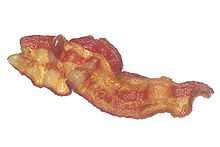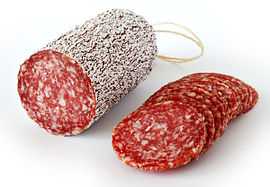Kranjska klobasa
| Kranjska klobasa | |
|---|---|
 Käsekrainer variety of Kranjska klobasa | |
| Alternative names | Kransky, Krainer Wurst, luganighe de Cragno |
| Course | Sausage |
| Place of origin | Slovenia |
| Region or state | Gorenjska |
| Main ingredients | pork, garlic |
|
| |
Kranjska klobasa (Australian English: Kransky, German: Krainer Wurst, Italian dialect of Trieste: luganighe de Cragno) is a Slovenian sausage most similar to what is known as kielbasa or Polish sausage in North America.
The noun klobasa refers to a small sausage generally served whole (in contrast to salama) in Slovene. The adjective kranjska derives from the region of Carniola (Kranjska in Slovenian, Krain in German), which used to be a province in the Austro-Hungarian Empire. The earliest mention of the kranjska klobasa in German is found in Katarina Prato's renowned cookbook Süddeutsche Küche (South German Cooking, 1896, first edition 1858). The Slovenian term kranjska klobasa was first mentioned in the sixth edition of Slovenska kuharica (Slovene Cookbook) by Felicita Kalinšek in 1912.[1]
Kranjska klobasa contains at least 75-80% pork (aside from bacon), and at most 20% bacon. It may contain as much as 5% water, sea salt from Sečovlje salt pans, little garlic, saltpetre and black pepper. No other ingredients are permitted. The meat must be cut in small pieces 10 to 13 mm and bacon 8 to 10 mm. The filling is stuffed into pork intestine with a diameter of 32 to 36 mm. They are formed in pairs of 12 to 16 cm lengths and a weight of 180 to 220 grams. Pairs are linked together with a wooden skewer. The sausages are hot smoked and heat-cured at about 70 °C (158 °F).
Variations and preparation
The Käsekrainer is a variation of this sausage made with small chunks of cheese. Käsekrainer contains 10% to 20% cheese (e.g., Emmentaler) cut in small cubes. Käsekrainer were first made on a large scale in Austria in the early 1980s. Today they are a standard offering at sausage stands (Würstelstand). Käsekrainer can be boiled, baked or grilled. It is essential to keep them on low to medium heat; otherwise the outside is burned and the inside is still cold. Care should be taken when preparing them, because the cheese can become quite hot; the sausages should not be cut or poked while cooking, otherwise the melting cheese would be released.
The sausage can be served with curry on top; mustard, ketchup, and a piece of dark bread or in the most common form in Austria as a Käsekrainer-Hot-Dog. (By Hot Dog Austrians mean the bun not the sausage.) The bread used is very similar to a French baguette, but shorter (200 to 250 mm (7.9–9.8 in) long). The bun is cut open at one end and a hole is poked into it with a warm 1-inch-diameter (25 mm) metal rod. The next step is to put sauce in the hole. Austrians usually select from the following three: sharp mustard, sweet mustard, and ketchup. Often the choice is ketchup and one - or even both - of the mustards.
Kranjska klobasa is known as Kransky in Australia, to where it was introduced by post-war immigrants from Slovenia in the late 1940s and 1950s. The Kransky is very popular in Australia and New Zealand. The Waiters Club in Melbourne, Australia, is renowned worldwide for its wide range of Kransky dishes.
Controversy
Slovenia wants European Union Protected Designation of Origin (PDO) status for its Kranjska klobasa,[2] over the objections of Austria and Croatia.[3][4]
See also
References
- ↑ Bogataj Janez (2007). Taste Slovenia. Rokus Gifts. ISBN 978-9-6165-3139-9.
- ↑ "Kranjska klobasa". Publication of an application pursuant to Article 6(2) of Council Regulation (EC) No 510/2006 on the protection of geographical indications and designations of origin for agricultural products and foodstuffs. Council Regulation (EC) No 510/2006 file. EC No: SI-PGI-0005-0764-24.03.2009
- ↑ BBC News: Austria-Slovenia food fight over Krainer sausage
- ↑ "Croatia fumes over Slovenia's Kranjska sausage claim". BBC News. 21 August 2012. Retrieved 2012-08-21.
External links
| ||||||||||||||||||||||||||||||||||

